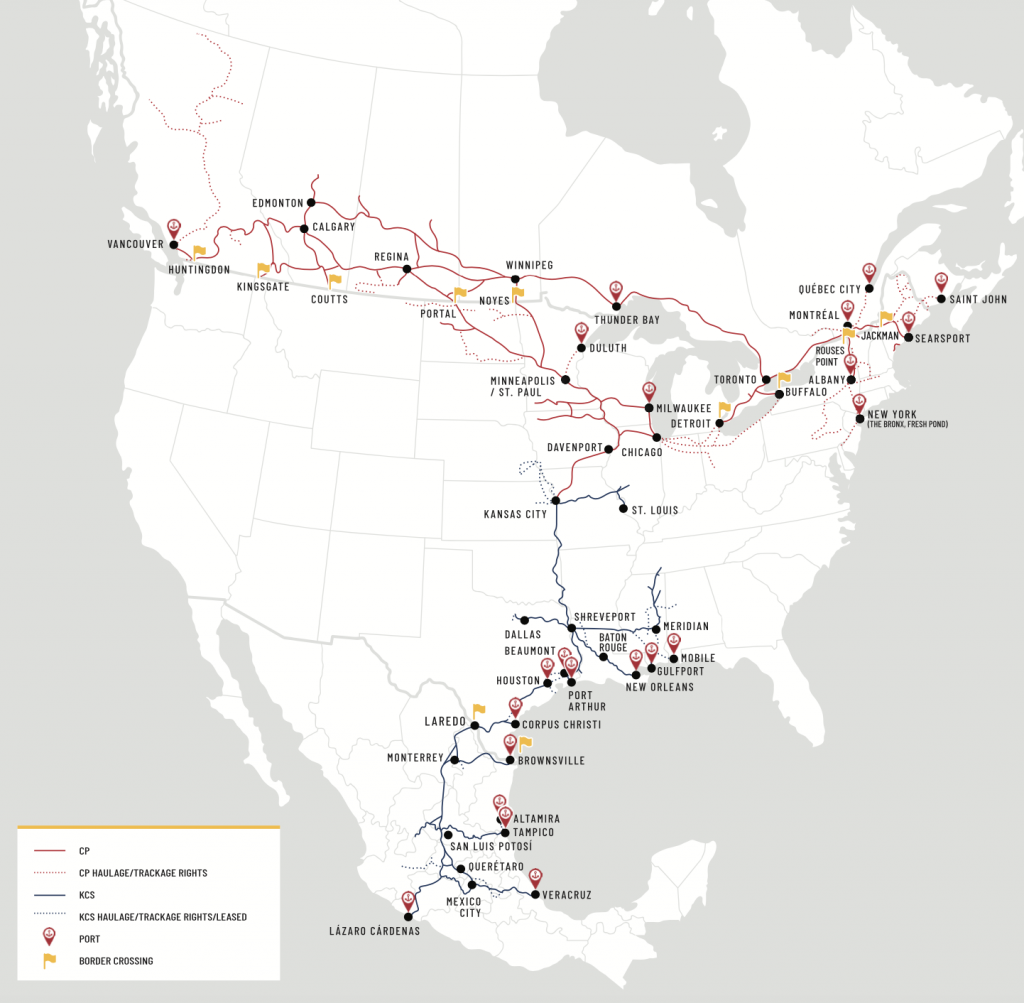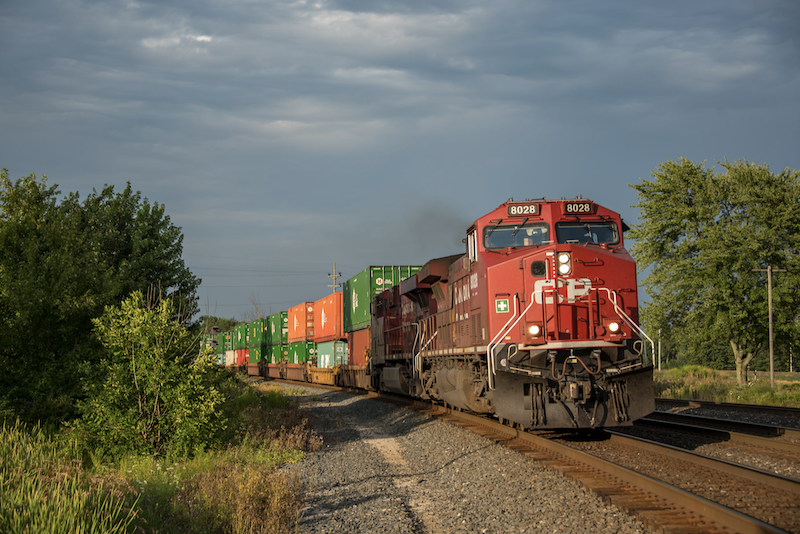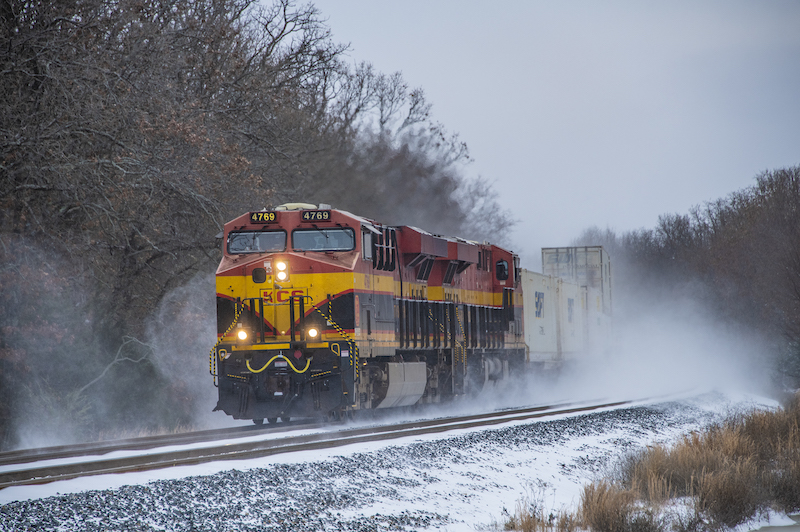- The U.S. Surface Transportation Board announced Wednesday it would allow Canadian Pacific to merge with Kansas City Southern on or after April 14.
- STB rejects Canadian Nationl’s request that it get KCS lines from Springfield, Ill. to Kansas City as a condition of the merger.
- The STB voted on the merger on Monday; four members voted for it and one, Robert Primus, voted against it.
By Justin Franz
UPDATED: 4:15 p.m. EST a.m., March 15
WASHINGTON — The U.S. Surface Transportation Board announced on March 15 that it would approve Canadian Pacific’s acquisition of Kansas City Southern resulting in the largest railroad consolidation in a generation and the first since the merger mania of the 1990s.
The combined railroad is expected to be called Canadian Pacific Kansas City and the two railroads will officially be able to merge on or after April 14.
“We made this decision because on the balance the merger of these two railroads will have a positive impact on the American economy and improve, for all citizens, safety and the environment,” said Chairman Martin Oberman during a press conference shortly after the decision was released.
The merger of North America’s two smallest Class I railroads will result in the biggest shift in railroading since Conrail was split between CSX Transportation and Norfolk Southern in 1999. It will also likely be the last merger ever between two major railroads — at least as long as the STB maintains its stance that any more consolidation would be bad for competition — and will permanently freeze the Class I landscape with six major carriers. CPKC will oversee 19,200 miles of track connecting the U.S., Canada and Mexico, the first railroad to touch all three countries. CP CEO Keith Creel will be the leader of the combined company that will be headquartered in Calgary.

A map of the combined Canadian Pacific and Kansas City Southern systems.
The ruling came about a week shy of the second anniversary of CP and KCS announcing their intentions to merge on March 21, 2021. While other mergers had been proposed since the STB put out new consolidation rules in 2001 — most notably CP and CSX Transportation in 2014, and CP and Norfolk Southern in 2016 — observers instantly concluded that this was the most likely to succeed. It is also important to note that those new merger rules had an exception: Any merger with KCS would be governed by the pre-2001 merger rules. However, it almost didn’t happen. A month after CP and KCS revealed their plans, Canadian National announced it was interested in acquiring KCS. CN offered more money and KCS quickly took the offer, setting off a frenzied battle between the two Canadian carriers. But then a bombshell: The STB announced in September 2021, it would not let CN put KCS into a blind trust, essentially derailing that consolidation. The STB also hinted that it would never approve another merger beyond that of CP and KCS. KCS went crawling back to CP and within days the original merger was back on — pending federal approval. Since then, the two railroads have been subjected to a rigorous review by the STB one which finally came to a conclusion on March 15.
After it was clear that CN was not going to be able to merge with KCS, the former began asking for concessions, including that CPKC sell the Springfield, Ill., to Kansas City and East St. Louis route to it. The STB decided on March 15 that it would not make that a condition of the merger, noting that its job was to “protect competition and not competitors.” The board also denied requests from Norfolk Southern and BNSF Railway for trackage rights in certain regions.
Read The Full STB Decision Here
The STB noted that even merged into one, CPKC would be the smallest of North America’s Class I railroads and that it would be a true “end-to-end” merger, meaning rail shippers were likely to benefit from additional reach. However, to ensure that shippers, rail passengers and other stakeholders are not negatively impacted, the STB was implementing an “unprecedented” seven-year oversight period over the merged railroad. That meant CPKC would have to give regular updates to the board on its operations and prove that critical interchange gateways remained open at commercially reasonable rates.
Amtrak was an early supporter of the merger after forging an agreement with CP and KCS to expand passenger service on certain routes, including between New Orleans and Baton Rouge, La., and between Meridian, Miss., and Dallas. The STB applauded those agreements and vowed to ensure that CPKC followed through on the promise.
One passenger railroad that did not support the merger was Chicago’s Metra, which worried that increased freight traffic as a result of the deal would negatively impact its passenger trains. The STB considered that, but ultimately decided that the eight extra freight trains in the Chicago area resulting from a combined CP-KCS would not be a major issue in an area that already hosts 1,300 trains per day.
The board’s vote on the merger occurred this week and was not unanimous, with member Robert Primus voting against it. In the overall decision, the board noted that not everyone would agree with having another merger.
“The Board recognizes that some in the shipping community and among antitrust commentators are not satisfied with the consolidation among Class I railroads that occurred following the Staggers Rail Act of 1980, and the Board itself has done its best to address how the Class I railroads behave today,” the decision reads. “Indeed, there is an ongoing debate about whether there has already been too much consolidation in the rail industry. Regardless of which side one takes in that debate, the Board is charged by Congress with reviewing the proposed merger in light of the state of the industry as it actually exists.”

-Photo by Steve Barry
CP and KCS officials were exuberant about the board’s decision. Shortly after the decision was published, CP issued a press release stating that it was reviewing the STB’s decision and would be putting out more information in the coming days about how the two railroads would be merged. CP has held KCS in a blind trust since 2021.
“This decision clearly recognizes the many benefits of this historic combination,” said CP CEO Keith Creel. “As the STB found, it will stimulate new competition, create jobs, lead to new investment in our rail network, and drive economic growth.
“This important milestone is the catalyst for realizing the benefits of a North American railroad for all of our stakeholders,” said Patrick J. Ottensmeyer, KCS President and Chief Executive Officer. “The KCS Board of Directors and management team are very proud of the many contributions and achievements of the people who have made KCS what it is today and we are excited for the boundless possibilities as we move forward into the next chapter as CPKC.”
During a press conference, the issue of safety was raised a number of times, especially as the fallout from NS’ explosive wreck in Ohio continues. Oberman said safety was a major consideration, but that he believed it would be increased with a combined CP-KCS. He also noted that shipping hazardous materials via rail is much safer than by truck.
Following that derailment last month, a number of elected leaders asked the STB to pause its decision on the merger and look at the data further. But Oberman said there was no way the board could study the merger more than it did.
“I’m confident that this data cannot be studied any further,” he said. “If we studied it further, our eyes would fall out.”
Reaction From Across Railroading…
“I want to thank the STB for this historic decision, which will ultimately result in a long working relationship with CPKC. This is a win for passenger rail service in our southern states and will positively impact all priority projects established by the SRC. SRC will work as a trusted partner to CPKC in making passenger rail service a more available mode of transportation for all.” —Knox Ross, Chairman of Southern Rail Commission.
“Amtrak congratulates Canadian Pacific and Kansas City Southern on their newly approved merger. We believe this merger will have a significant and positive effect on Amtrak intercity passenger rail service.” —Stephen J. Gardner, CEO of Amtrak.
“BMWED anticipated the Board’s approval of the CP/KCS Merger, so we are not surprised by the STB’s decision. BMWED agrees with the Board’s determination requiring Labor Protections and Cramdown, and we expect CP to abide to those terms as they stated they would in their filings before the Board. Cramdown applies when the carrier wants to consolidate or coordinate formerly separate territories (CP vs. KCS territories), and two or more existing collective bargaining agreements are involved, the union(s) can pick the agreement that will apply to the consolidated/coordinated locations. CP also stated in their filings that this merger would create improvements in carrier services, and create over 750 jobs in the railroad industry. We anticipate the increase in employment in the freight rail industry and the related improvement in services. Forty years ago, there were many more freight rail carriers than there are today, and many of the railroads at that time were experiencing significant financial difficulties. Those circumstances do not remain today. The Class I freight railroads have been on a decades plus run of record profits, and with the approval of this merger, the U.S class I railroad carriers are now certainly consolidated into effective duopolies and they all remain positioned to be extremely profitable for the years to come. But there remains a serious concern in the industry regarding the level of quality of service the carrier’s provide, and the long-term viability of attracting and retaining talent in the industry. In other words, we need a regulatory regime for the industry that exists today not the one that existed in the 1980s. We need a regime that encourages the STB to ensure that the service commitments that were made in connection with the carrier mergers are adhered to, that the railroads live up to their common carrier obligations and that they act consistent with the 49 U.S.C. 10109 – National Rail Transportation Policy, Sections (9) and (11), which are “to encourage honest and efficient management of railroads” and “to encourage fair wages and safe and suitable working conditions in the railroad industry.” —Statement from Brotherhood of Maintenance of Way Employees.
This is a developing story. It will be updated as more information becomes available.



